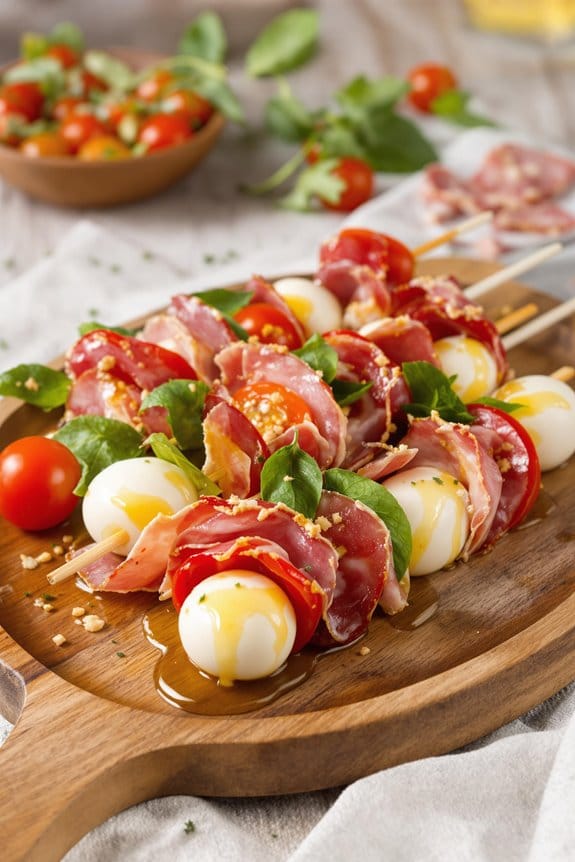You’ve probably enjoyed them at parties or contemplated making them for a quick appetizer, but have you ever stopped to think about the origins of antipasto skewers with salami and mozzarella? These skewers aren’t just a tasty combination of flavors; they’re a glimpse into centuries of Italian culinary tradition, right down to the simplicity of their assembly and the freshness of their ingredients. What might seem like a simple dish carries with it stories of cultural gatherings and artful cuisine, making each bite a bridge to Italy’s rich gastronomic history. Now, isn’t that something to reflect on next time you’re threading those ingredients onto a skewer?
History
Antipasto skewers might seem like a modern party favorite, but their roots are deeply embedded in Italian culinary history.
Originally, “antipasto” refers to the starter course in a traditional Italian meal, designed to stir up your appetite before the main dishes arrive. This concept hails from as far back as medieval Italy, where diners would indulge in varied small bites such as cured meats, olives, and cheeses, setting the tone for the culinary delights to come.
Over time, the presentation has evolved, fitting the fast-paced lifestyle of modern diners who crave the essence of Italian flavors in a single, convenient bite. Consequently, antipasto skewers captured the essence and simplicity of traditional Italian fare, becoming a beloved snack worldwide.
Recipe
Antipasto skewers are a colorful and appetizing way to kickstart any gathering, blending the savory delights of Italian cuisine with the charm of small bites. This dish is versatile, perfect for parties, quick appetizers, or as a light meal with Italian flair.
The beauty of antipasto skewers lies in their simplicity and the playful possibility of customization. Each skewer can hold a mixture of tastes and textures, from tangy marinated artichokes to creamy mozzarella balls, all brought together with a drizzle of balsamic glaze or olive oil to augment the flavors.
Preparing antipasto skewers is as easy as it’s enjoyable. Start by selecting a range of ingredients that offer contrasting and complementary flavors and textures. Think of including various cured meats, cheeses, vegetables, and even fruits for a touch of sweetness.
The key is to choose items that not only taste great together but also create an appealing visual presentation. Once assembled, these skewers can serve as a standalone snack or be paired with other dishes for a full meal, making them perfect for any culinary occasion.
Ingredients:
- Cherry tomatoes
- Mozzarella balls (bocconcini)
- Fresh basil leaves
- Black olives, pitted
- Artichoke hearts, halved
- Cured meats (such as salami or prosciutto), cut into bite-sized pieces
- Roasted red peppers, cut into squares
- Balsamic glaze or extra virgin olive oil (for drizzling)
- Salt and pepper to taste
- Wooden skewers
Instructions:
Begin by washing and drying all fresh produce. On each wooden skewer, thread a cherry tomato, followed by a folded piece of cured meat, a mozzarella ball, a basil leaf, an artichoke heart, a piece of roasted red pepper, and an olive.
Repeat the process until the skewer is nicely filled, leaving a bit of space at each end to handle them easily. Once all skewers are assembled, arrange them on a platter. Drizzle with balsamic glaze or olive oil and season with salt and pepper to taste. Serve immediately, or cover and refrigerate until needed.
Additional Tips:
When assembling the skewers, keep in mind the balance of colors and textures to make each skewer visually appealing. For a more robust flavor, consider marinating the mozzarella balls in a mixture of olive oil, herbs, and garlic before skewering.
Additionally, if planning for a summer event, you can grill the skewers briefly before serving to add a delightful char and warmth to the dish. Using ingredients of similar size not only guarantees even cooking but also makes the skewers easier to eat.
Finally, offer a variety of dips, such as pesto or a cream-based dip, to complement the skewers’ flavors.
Step 1. Assemble Skewer Ingredients
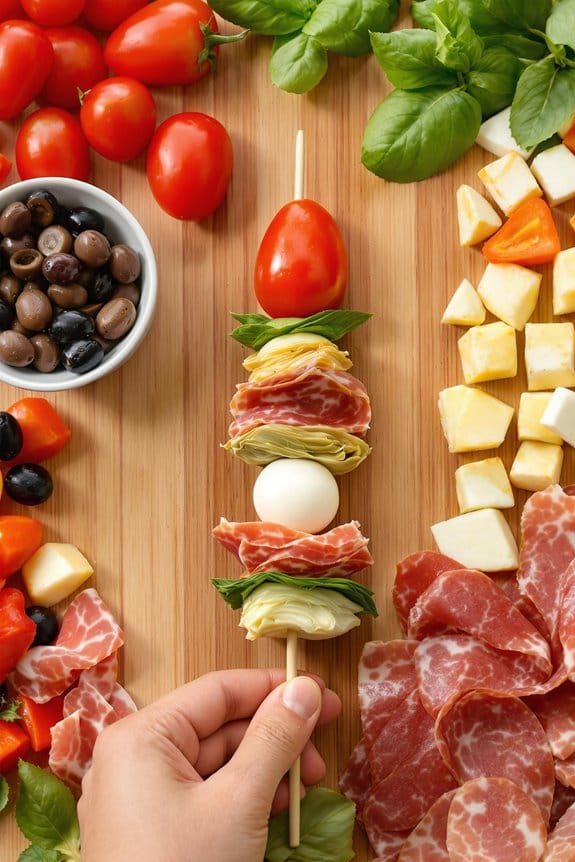
Begin by gathering all your skewer ingredients. You’ll need small skewers or toothpicks to start assembling.
Lay out your salami slices, choosing either spicy or mild depending on your preference. Next, select your olives—both green and black varieties add a nice color contrast and a blend of flavors.
Include cherry tomatoes for a burst of juiciness and a vibrant touch. Decide on artichoke hearts and roasted red peppers to give your skewers an extra layer of flavor and a Mediterranean flair.
Have these components ready on your workspace so you can begin the fun part of skewering them in an appealing order that pleases both the eye and the palate.
Step 2. Add Cheese and Basil Leaf
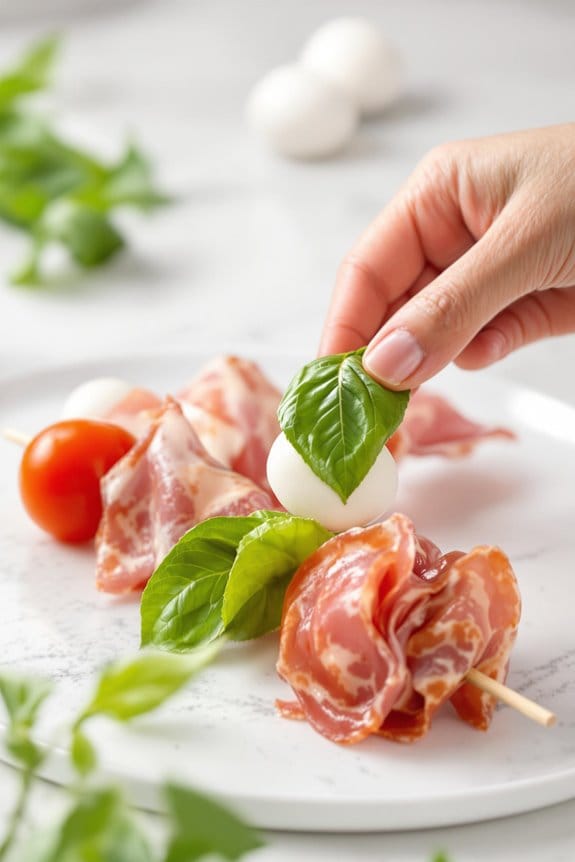
Now that you’ve laid out your meats, vegetables, and olives, it’s time to enhance the flavors with the addition of cheese and a basil leaf.
Choose small bites of mozzarella for their creamy texture and mild taste, which will complement the robust flavors of salami and salty olives beautifully. Simply thread a piece of cheese onto each skewer.
Next, add a fresh basil leaf between the cheese and the next component. The basil introduces a burst of freshness and an aromatic touch that ties all the elements together superbly.
Be sure to use whole leaves; they’re not only prettier on the skewers but also pack more flavor. This layering brings a delightful diversity to each bite of your antipasto skewer.
Step 3. Drizzle Olive Oil
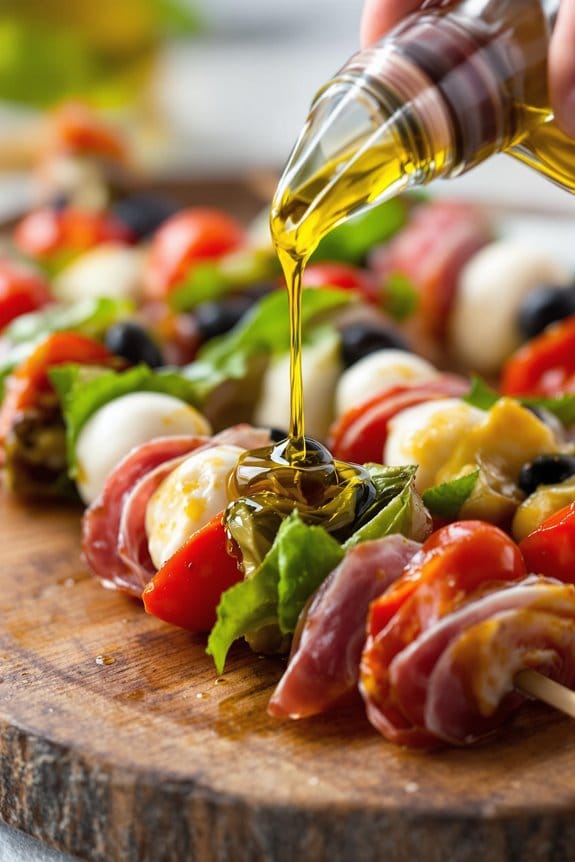
To finish off your skewers with a flourish, drizzle them lightly with olive oil. This isn’t just about adding a touch of moisture.
That generous pouring enhances the flavors mingling on your skewer—deepening the savory notes of salami and the creaminess of mozzarella. It’s essential to choose a good quality extra virgin olive oil; its robust flavor is crucial.
Don’t go overboard, just a gentle cascade over each skewer will do. This simple gesture marries the ingredients with a silkiness that only a fine oil can impart.
It’s like the final note in a symphony, unobtrusive yet significant. This isn’t just assembling ingredients; you’re crafting delightful bites that sing with every layer.
Step 4. Insert Cherry Tomatoes
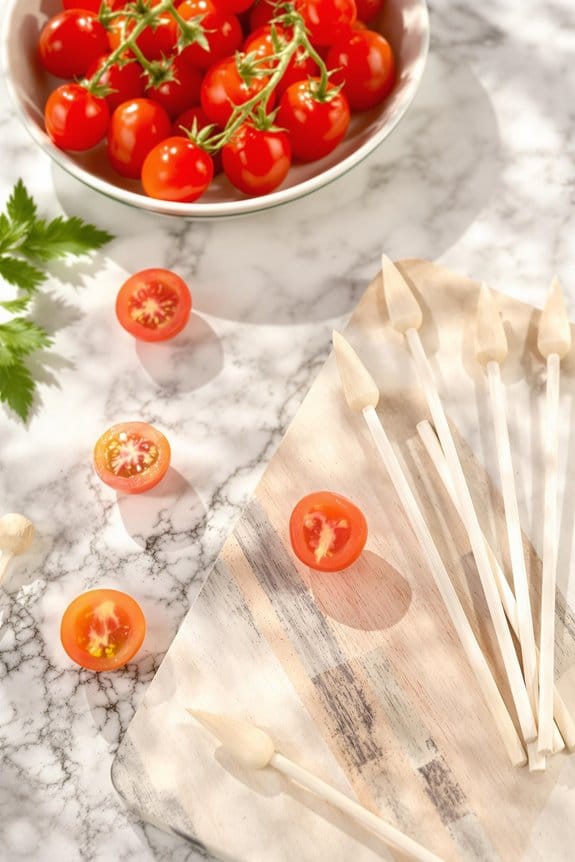
After drizzling your skewers with olive oil, turn your attention to the vibrant cherry tomatoes.
You’ll want to choose firm, bright red tomatoes for the best texture and flavor. Carefully slide each cherry tomato onto your skewers, alternating with the other ingredients such as salami, mozzarella, and perhaps a basil leaf. This not only creates a visually appealing pattern but also guarantees a well-rounded taste with each bite.
Regarding placement, it’s wise to sandwich the tomatoes between items that hold well on the skewer, such as folded salami and chunks of mozzarella to prevent sliding.
Confirm each skewer has an equal number of tomatoes to maintain consistency in flavor and presentation, highlighting the fresh, tangy pop of the tomatoes in your antipasto ensemble.
Step 5. Season With Salt and Pepper
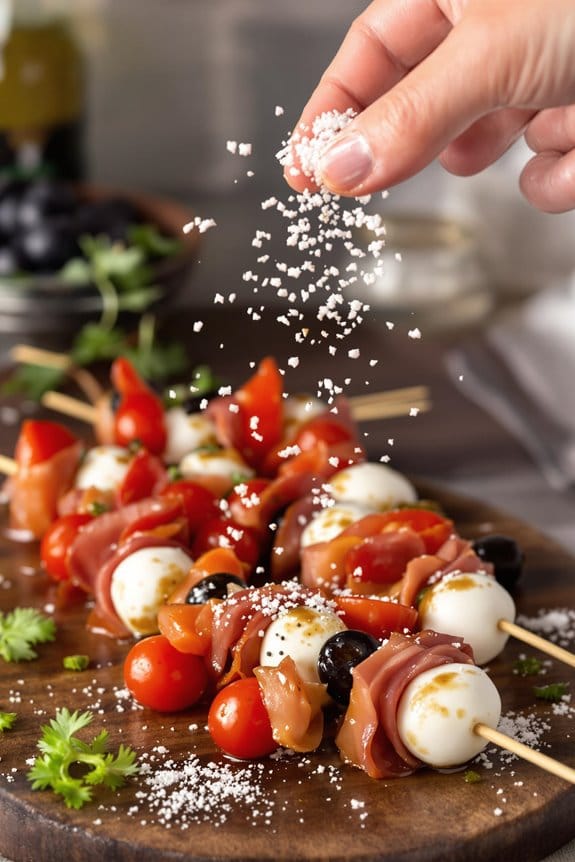
Once you’ve assembled your skewers, give them a generous seasoning with salt and freshly ground black pepper.
This final touch enhances the flavors of the salami, mozzarella, and cherry tomatoes, bringing out their best qualities.
Sprinkling the right amount of seasoning isn’t just a detail—it transforms your skewers from good to fantastic.
Why season your skewers? Here’s why it matters:
- Boosts Flavor: Salt and pepper intensify and elevate the natural flavors.
- Adds Depth: Each bite is more dynamic and satisfying.
- Visual Appeal: They add a subtle, speckled appearance.
- Customizable: Adjust the amount to suit your taste preferences.
- Universal Appeal: Almost everyone enjoys the classic combo of salt and pepper.
New Recipe
- Pepperoni and Hot Honey PizzaTry the tantalizing twist of pepperoni pizza with hot honey, where sweet meets heat—how will it transform your taste buds?
Cooking Tips
Many people find assembling antipasto skewers a bit intimidating, but with a few simple tips, you can make them like a pro.
First, opt for a variety of colors and textures. Include different types of meats, like salami or prosciutto, along with diverse cheeses such as mozzarella and provolone.
Don’t forget to add something briny, like olives or artichokes, to balance the flavors.
When assembling, keep your pieces uniform for the best visual appeal and ease of eating. Use sturdy skewers to guarantee everything stays in place.
Finally, give your skewers a good drizzle with olive oil and a sprinkle of Italian herbs before serving to boost flavor.
This way, you’ll impress every guest with your culinary craft.
Final Thoughts
Crafting antipasto skewers can elevate any gathering, bringing a touch of elegance and flavor to your table.
As you’ve seen, combining salami, mozzarella, and a variety of accompaniments isn’t just tasty—it’s also a striking way to welcome guests.
Here are distilled insights to keep in mind:
- Flexibility: Mix and match ingredients based on seasonal availability.
- Convenience: Prepare these skewers ahead of time and refrigerate.
- Variety: Offer several types of meats and cheeses.
- Presentation: Arrange skewers artistically on a platter.
- Flavor Balance: Pair sharp cheeses with milder cold cuts.

